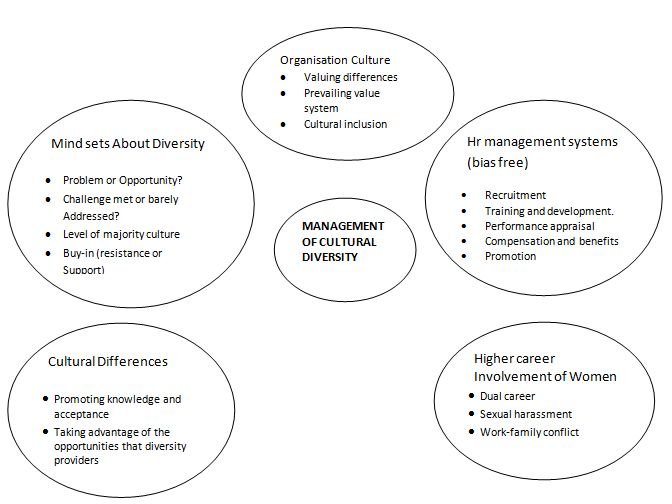Framework for Managing Diversity
Fig. 3.3 outlines seven spheres of activity that together provide a comprehensive framework for managing diversity.
Managing diversity consists of three related tasks which are described in fig. 3.3;2
Managing Cultural Diversity: In order to build a more diverse and effective workforce for the success of a company, it is necessary to manage cultural diversity. This will help the company by providing an advantage in recruitment, retention and
Taylor H. Cox, “Managing Cultural Diversity – Implications for Organizational Competitiveness” , Academy of Management Review, VOl. 5. August 1991.
Adapted from Thakur, Burton and Srivastava, OP.cit, pp. 40-42.
Motivation of workers. A culturally diverse workforce will maximise the company’s ability to deal with a culturally diverse marketplace. Culturally-diverse work teams ability to deal with a culturally-diverse consumers and other groups. Firms must develop cross-cultural training programme to help their employees become more sensitive to the cultures of their fellow employees.
- Managing Individual Diversity : In addition to learning to manage cultural adversity, companies must also learn to manage individual diversity. Within each culture, each individual may be different in many ways. Therefore, the American adage “different strokes for different folks” need to be applied carefully and selectively.
- Managing Workforce Diversity : As business enterprises become more global the challenges of diversity become complex. Success depends to a large extent on the ability to understand and manage workforce diversity. Many problems such as miscommunication, mistrust, poor cohesiveness and stereotyping may arise. These barriers of diversity can be overcome by a well-integrated system of oraganisation development.
A well-designed programme for management of diversity will consist of the following :
a) Strong and visible support from top management.
b) Continuous efforts to assess the diversity management programme.
c) Flexible programme for the recruitment. Training, retention and upward mobility of a diverse workforce.
d) Programmes to accommodate family needs, such as day-care and care for the elderly.
e) Alternative work schedules, including part time work, job sharing, compressed work weeks, flextime, etc.
f) Telecommuting opportunities for non-conventional workers and foreign workers who do not wish to immigrate.
g) Diversity and language training.
h) Mentoring or the use of high level managers to guide high potential women, minorities, and other diverse employees.
i) Support groups that can help build minority networks for the support and guidance of applicable employees.
j) Career development and promotions to maximise the upward mobility of diverse employees to overcome the glass ceilings that tend to hold them back.


